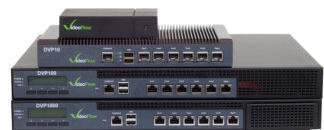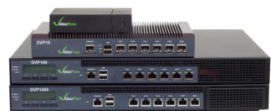



Digital Video Protection
IP networks have become the popular, low-cost choice for transporting data, voice
and video content. IP communications were originally designed to ensure data
integrity, where the criterion for success is complete delivery. If data packets arrive
late or are lost, protocols such as TCP exist to resend them without a major impact on
the user experience. When it comes to live video, however, completeness is not
enough. Packets must be delivered reliably and on time in order to ensure
uninterrupted, broadcast quality video. Unfortunately, the inherent nature of IP
networks, characterized by packet jitter, packet loss, and link capacity fluctuations –
makes them unreliable for professional live video broadcast.
VideoFlow’s Digital Video Protection (DVP) product is used by leading companies
worldwide to boost the reliability of IP networks, including the public Internet, for
professional live broadcast. DVP enables to confidently contribute and distribute live
video over IP with unprecedented levels of service continuity, at a fraction of the cost
of leased lines or satellite links. It accelerates ROI by reducing operational costs and
enabling new revenue streams across a wide variety of markets.
VideoFlow offers the DVP in a variety of form factors and capacities. You can choose
the right DVP for your needs and grow it as you need it by simply adding more
capacity and features as you need them with no interruption to the service.
Two DVPs will protect the quality of the video over any IP network connection
including the public Internet. The DVP comes as a “Plug and Play” pair – a Protector at
the source, which stores the packets until it is certain that they have been correctly
received, and a Sentinel at the destination which monitors the health of the video
stream by watching for packet loss and requests packets to be resent from the
Protector’s cache only if required. Nine layers of protection are making VideoFlow’s
DVP highly flexible working with any IP connection including the public Internet to
deliver the level of quality expected by professionals when broadcasting live.

DVP Specifications
:: MPEG TS Encapsulation
Input: MPEG TS over UDP or UDP/RTP, SPTS/MPTS, Unicast/Multicast, ASI
Output: MPEG TS over UDP or UDP/RTP, SPTS/MPTS, Unicast/Multicast
:: Video
Video Encoding: MPEG2, H.264, HEVC
Video Resolution: SD, HD, 2K, 4K, 8K
:: Continuity of Service
Controlled Adaptive Rate (CAR)
Load sharing / Stream duplication over multiple ISPs
Hit-less stream redundancy
Input stream fail over
Box redundancy
:: Security
IPSec VPN
Secured UDP VPN (AES128, AES256)
Firewall
:: Analysis and Statistics
ETSI TR 101 290 Priority 1, 2, 3 Compatible Statistics
PCR bit rate information
Packet rate
DVP Selection Guide













- Optics Overview
- Night Vision Overview
- Telescope Accessories
- Astrophotography Site
- Dwarf II AI Telescope Classic
- Dwarf II AI Telescope Deluxe
- SeeStar S50
- SarBlue Mak60 Telescope
- GoSky 20-60x80 Spotting Scope
- Gosky 20-60x80 ED Ultra HD
- GoSky 20-60x80 Waterproof
- GoSky 12x55 Monocular
- GoSky SmartPhone Adaptors
- GoSky Eagleview ED 10x42
- GoSky 10x42 Binoculars
- Night Vision NV400
- Night Vision DT49 4K Binocular
- Night Vision DT18 Monocular
- Night Vision DT19 Monocular
- Night Vision DT29 Binocular
- Night Vision DT39 Binocular
- Night Vision DT88 Binocular
- Night Vision DT99 Binocular
- DH1 Trail Camera
- DT40 12x32 Binocular Camera
- Vehicle /Car Window Mount
- Optics Catalogue - download


- Fosi Audio Overview
- Fosi Audio BT20A
- Fosi Audio BT20A Pro Amp
- Fosi Audio BL20A
- Fosi Audio BT30D Pro
- Fosi Audio V3 Amplifier
- Fosi Audio MC351
- Fosi Audio AK170
- Fosi Audio ZK-1002D
- Fosi Audio BT30D
- Fosi Audio TB10D
- Fosi Audio T10 WiFi Amp
- Fosi Audio B2 Speaker
- Fosi Audio C4 Speaker
- Fosi Audio A5 Soundbar
- Fosi Audio K5 Pro Gaming Dac
- HDMI 4x8 Matrix Cat5e/6
- Audio Catalogue - download


- Press Releases
- Graphic Image Technologies announces the availability of DVTEL Meridian 2TB and 4TB
- Opinion Piece: 4K myths debunked
- The release of TVU One – a compact mobile All-In-One IP video transmission solution
- Quasar 4K Ultra HD Cameras from GIT take video surveillance quality to new heights
- Increasing integration capabilities are the future of commercial security solutions
- LC Sequ-door improves productivity and customer service with remote surveillance solution from GIT
- 7Arrows Security cracks down on Petervale crime with SerVision and DVTel solution from GIT
- CCTV with remote monitoring boosts security, offers additional benefits for public transport sector
- CCTV with remote monitoring is the ultimate business security and productivity tool
- DVTEL Quasar 4K Ultra HD Cameras from GIT take video surveillance quality to new heights
- GIT and Secusystems use Servision to cut illegal mining in Tanzania and Ghana by 50%
- Thermal imaging cameras can bolster anti-poaching initiatives
- GIT offers customer training on DVTel analytics solutions
- GIT offers new dvtel intelligent thermal imaging cameras with analytics
- Five rules to help you make the most of your CCTV solution
- GIT to distribute full range of dvtel solutions
- Live proactive monitoring and surveillance helps curb cash-in-transit heists
- Instantly share live video between multiple broadcast facilities with the TVU Grid from GIT
- GIT offers the full range of TVU products
- Thava Restaurant Improves service Levels with SerVision
- Video Flow for Broadcasting over the internet
- GIT Supports Olivers House
- GIT showcases innovative solutions at Mediatech
- ATM CCTV Solution
- Leveraging additional value from Video Surveillance Solutions
- Reducing Theft of Goods in Transit
- Local and Global Mining CCTV
- Lowering Risk in Businesss Parks
- Someone to watch over our children
- Supersizing remote Surveillance
- Vehicle Monitoring
- Mobile CCTV
- Retail Surveillance over Narrow band
- Remote CCTV and Holiday Homes
- 5 Common Misconceptions in CCTV
- Before you throw out analogue security cameras in favour of IP
- Case Study: Productivity Tool
- School Bus Mobile DVR Project
- Harmonic used to provide SABC SWC 2010 Video
Broadcast Technologies - VideoFlow
Products-VideoFlow

© Graphic Image Technologies 2021



































































































































































































































































































































































































What we do
VideoFlow helps companies boost the reliability of IP networks, including the public Internet, for efficient transport of professional live video. With our proven DVP product, you'll be able to slash costs without sacrificing a single pixel of video quality.
With VideoFlow Without ideoFlow
The Products
VideoFlow’s digital video protection (DVP) product line turn the
Internet into a live content distribution network by leveraging on
VideoFlow’s 3V technology to maximize the quality of your video
streams while minimizing cost!!






White Papers:












- Optics Overview
- Night Vision Overview
- Telescope Accessories
- Astrphotography Solutions
- Dwarf II AI Telescope Classic
- Dwarf II AI Telescope Deluxe
- SeeStar S50
- SarBlue Mak60 Telescope
- GoSky 20-60x80 Spotting Scope
- GoSky 20-60x80 ED HD Spotting Scope
- GoSky 20-60x80 Waterproof Scope
- Gosky 12x55 Monocular
- GoSky Smartphone Adaptor
- GoSky EagleView ED10x42
- GoSky 10x42 Binoculars
- Night Vision NV400 Binocular
- Night Vision DT49 4K Binocular
- Night Vision DT18 Monocular
- Night Vision DT19 Monocular
- Night Vision DT29 Binocular
- Night Vision DT39 Binocular
- Night Vision DT88 Binocular
- Night Vision DT99 Binocular
- DH1 Trail Cam
- DT40 12x32 Binocular Camera
- Vehicle Car Window Mount
- Optics Catalogue - download


- Fosi Audio Overview
- Fosi Audio BT20A
- Fosi Audio BL20A
- Fosi Audio BT20A Pro
- Fosi Audio MC351
- Fosi Audio V3 Amplifier
- Fosi Audio AK170
- Fosi Audio ZK-1002D
- Fosi Audio BT30D
- Fosi Audio BT30D Pro
- Fosi Audio TB10D
- Fosi Audio T10 WiFi Amp
- Fosi Audio B2 Speaker
- Fosi Audio C4 Speaker
- Fosi Audio A5 Soundbar
- Fosi Audio K5 Pro Gaming DAC
- HDMI 4x8 Matrix Cat5e/6
- Audio Catalogue


- About
- BEE Certificate
- Clients
- Press Releases
- Graphic Image Technologies announces the availability of DVTEL Meridian 2TB and 4TB
- Opinion Piece: 4K myths debunked
- The release of TVU One – a compact mobile All-In-One IP video transmission solution
- Quasar 4K Ultra HD Cameras from GIT take video surveillance quality to new heights
- Increasing integration capabilities are the future of commercial security solutions
- LC Sequ-door improves productivity and customer service with remote surveillance solution from GIT
- 7Arrows Security cracks down on Petervale crime with SerVision and DVTel solution from GIT
- CCTV with remote monitoring boosts security, offers additional benefits for public transport sector
- CCTV with remote monitoring is the ultimate business security and productivity tool
- DVTEL Quasar 4K Ultra HD Cameras from GIT take video surveillance quality to new heights
- GIT and Secusystems use Servision to cut illegal mining in Tanzania and Ghana by 50%
- Thermal imaging cameras can bolster anti-poaching initiatives
- GIT offers customer training on DVTel analytics solutions
- GIT offers new dvtel intelligent thermal imaging cameras with analytics
- Five rules to help you make the most of your CCTV solution
- GIT to distribute full range of dvtel solutions
- Live proactive monitoring and surveillance helps curb cash-in-transit heists
- Instantly share live video between multiple broadcast facilities with the TVU Grid from GIT
- GIT offers the full range of TVU products
- Thava Restaurant Improves service Levels with SerVision
- Video Flow for Broadcasting over the internet
- GIT Supports Olivers House
- GIT showcases innovative solutions at Mediatech
- ATM CCTV Solution
- Leveraging additional value from Video Surveillance Solutions
- Reducing Theft of Goods in Transit
- GIT offering reduces theft of goods in transit
- Local and Global Mining CCTV
- Lowering Risk in Businesss Parks
- Someone to watch over our children
- Supersizing remote Surveillance
- Vehicle Monitoring
- Mobile CCTV
- Retail Surveillance over Narrow band
- Remote CCTV and Holiday Homes
- 5 Common Misconceptions in CCTV
- Before you throw out analogue security cameras in favour of IP
- Case Study: Productivity Tool
- School Bus Mobile DVR Project
- Harmonic used to provide SABC SWC 2010 Video
- Section 51
Broadcast Technologies - VideoFlow

© Graphic Image Technologies 2021


































































































































































































































































































































































































Digital Video Protection
IP networks have become the popular, low-cost choice for
transporting data, voice and video content. IP
communications were originally designed to ensure data
integrity, where the criterion for success is complete
delivery. If data packets arrive late or are lost, protocols
such as TCP exist to resend them without a major impact
on the user experience. When it comes to live video,
however, completeness is not enough. Packets must be
delivered reliably and on time in order to ensure
uninterrupted, broadcast quality video. Unfortunately, the
inherent nature of IP networks, characterized by packet
jitter, packet loss, and link capacity fluctuations – makes
them unreliable for professional live video broadcast.
VideoFlow’s Digital Video Protection (DVP) product is used
by leading companies worldwide to boost the reliability of
IP networks, including the public Internet, for professional
live broadcast. DVP enables to confidently contribute and
distribute live video over IP with unprecedented levels of
service continuity, at a fraction of the cost of leased lines
or satellite links. It accelerates ROI by reducing
operational costs and enabling new revenue streams
across a wide variety of markets.
VideoFlow offers the DVP in a variety of form factors and
capacities. You can choose the right DVP for your needs
and grow it as you need it by simply adding more capacity
and features as you need them with no interruption to
the service.
Two DVPs will protect the quality of the video over any IP
network connection including the public Internet. The
DVP comes as a “Plug and Play” pair – a Protector at the
source, which stores the packets until it is certain that
they have been correctly received, and a Sentinel at the
destination which monitors the health of the video
stream by watching for packet loss and requests packets
to be resent from the Protector’s cache only if required.
Nine layers of protection are making VideoFlow’s DVP
highly flexible working with any IP connection including
the public Internet to deliver the level of quality expected
by professionals when broadcasting live.

What we do
VideoFlow helps companies boost the reliability of IP networks, including the public Internet, for efficient transport of professional live video. With our proven DVP product, you'll be able to slash costs without sacrificing a single pixel of video quality.
The Products
VideoFlow’s digital
video protection
(DVP) product line
turn the Internet
into a live content
distribution
network by leveraging on VideoFlow’s 3V technology to maximize the
quality of your video streams while minimizing cost!!












DVP Selection Guide
DVP Specifications
:: MPEG TS Encapsulation
Input: MPEG TS over UDP or UDP/RTP, SPTS/MPTS, Unicast/Multicast, ASI
Output: MPEG TS over UDP or UDP/RTP, SPTS/MPTS, Unicast/Multicast
:: Video
Video Encoding: MPEG2, H.264, HEVC
Video Resolution: SD, HD, 2K, 4K, 8K
:: Continuity of Service
Controlled Adaptive Rate (CAR)
Load sharing / Stream duplication over multiple ISPs
Hit-less stream redundancy
Input stream fail over
Box redundancy
:: Security
IPSec VPN
Secured UDP VPN (AES128, AES256)
Firewall
:: Analysis and Statistics
ETSI TR 101 290 Priority 1, 2, 3 Compatible Statistics
PCR bit rate information
Packet rate


































